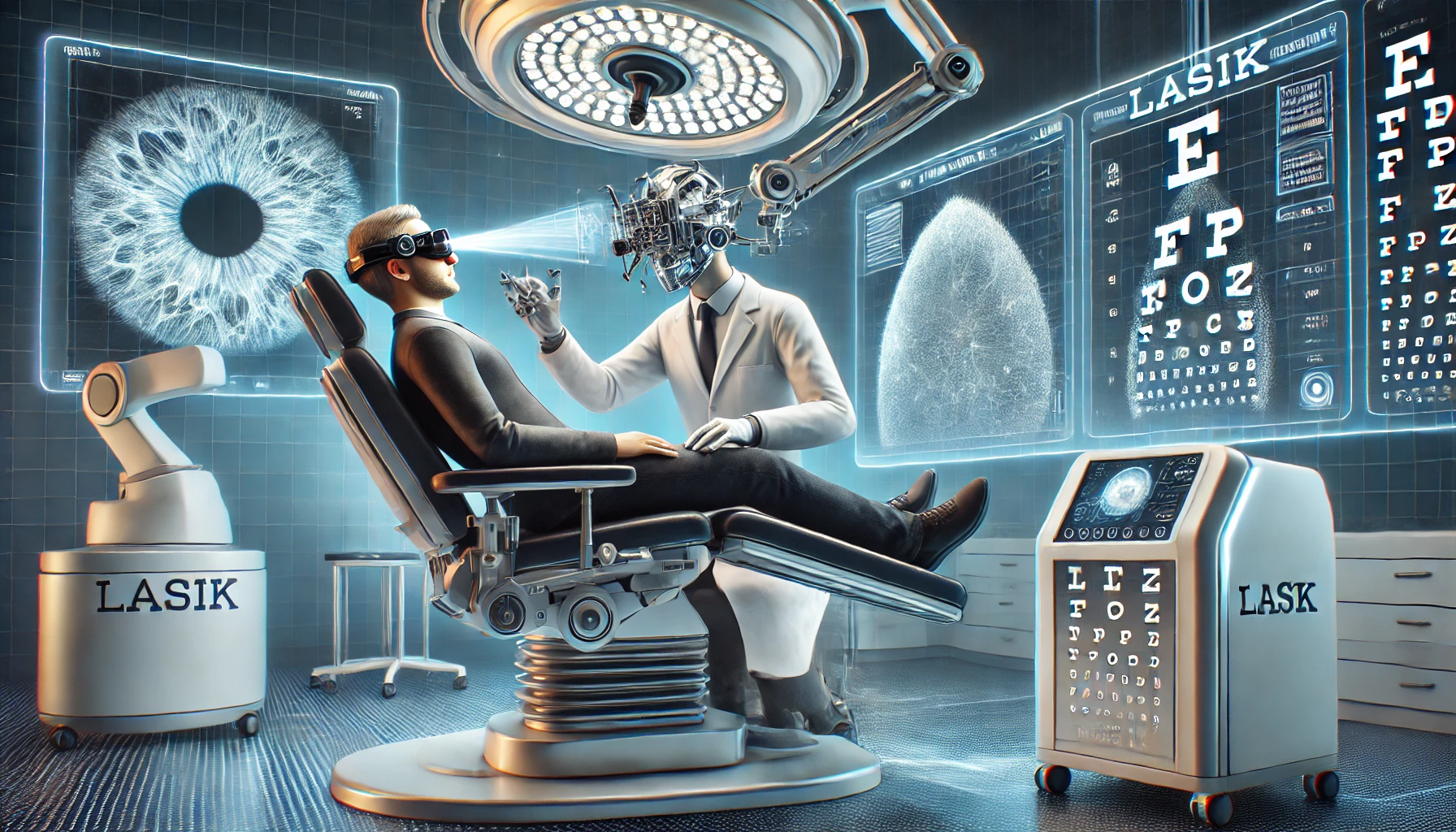LASIK Surgery
LASIK (Laser-Assisted in Situ Keratomileusis) is a popular vision correction surgery used to treat refractive errors such as myopia (nearsightedness), hyperopia (farsightedness), and astigmatism. This procedure reshapes the cornea to improve the way light is focused onto the retina, reducing or eliminating the need for glasses or contact lenses.
Many of you having Myopia would have considered LASIK Surgery but you are too confused or scared or are very concerned due to lack of proper information. You can always reach out to Doctors (Ophthalmologists) for their expert advice as each case is different. We are taking a different approach, we are sharing the experience of a person who had undergone LASIK Surgery.
(Note – We don’t have any connections with any Hospitals, Doctors nor with anyone, this article is only to provide information and causing awareness)
This is the story of Chirag Barjatya (Dad. Entrepreneur. Building @thepfcclub – We will make you healthier and stronger while working on your Habits.)- Link to his X(Twitter) Post – Click Here
I had my LASIK eye surgery to fix my vision last week. Everything you need to know about why I went for LASIK, how the recovery was, where I went for it, what precautions I took, and so on is in this thread. Read only if you are planning for LASIK. Others can ignore. Also, the problems I am facing right now.
First, why did I go for surgery to remove the specs?
I have been wearing glasses for more than 10 years now. I broke them several times, spent vast amounts of money on different types of lenses, and made separate numbered sunglasses. But this was becoming a task in daily life: constantly taking care of the specs and keeping two of them, one for the sun and one for the night. Daily searching for specs upon waking up added another daily fatigue. Anyway, this was my call to go for LASIK.
I consulted Dr Nitin Prabhudesai at Dr Agarwals’ eye hospital in Kothrud, Pune. He suggested LASIK and gave me options for other advanced procedures, but I went for LASIK because it has the highest success rate and is cost-effective, per my budget.
What is the best treatment for you?
The doctor will suggest upon consultation.
Procedure and the process! Two visits in total. One was for the workup and to check if my cornea thickness was optimal for the surgery, and the other was for the surgery. Check up took – 30min. Surgery took 12 minutes in OT and 30 minutes in prep. That’s about it. I was at the home within 2 hours.
During surgery. They put some drops and put you under the machine. It pains a bit, like some sting, but only lasts 6 minutes per eye. And you will have to look at the green dot in the machine. You will get some burning smell as well during laser work.
Post Surgery: They asked to put drops on an hourly basis on the first day, and then some drops will continue for 2-3 months, twice a day, and some gel to apply every night.
My current condition after a week. I am back to lifting weights. I am back to screens. I did some night driving right now. The high beams look hazy, but the doctor said it will be fine in 2-3 months. If you drive a lot in the evening, plan it accordingly. Putting drops thrice a day for now, it will reduce to twice a day after some time.
Now, I showed some of your questions to the doctor and he answered some of them. Pasting here;
My family is pushing me to get LASIK. I want to know everything, but most of all, the state of dryness. Also, I have heard people get dark circles a few months after LASIK. So an update on that as well, 6 mos later.
Answer: LASIK is a safe and effective procedure with a smooth recovery for most patients. Temporary dryness can occur but is manageable with lubricating drops and proper care. There is no direct link between LASIK and dark circles—good rest and hydration help maintain eye health
Minimum power needed, if any, for this surgery? Also, how did you evaluate that this is safe enough?
Answer: LASIK requires no strict minimum power, but it is generally performed for prescriptions of -1.0 D or higher for myopia and +1.0 D or higher for hyperopia, with stable vision. LASIK’s safety is evaluated through thorough pre-surgery screenings, including corneal thickness, eye health, and prescription stability. Advanced technology and decades of research ensure high safety standards, making it a reliable procedure for eligible candidates.
Is there any age constraint for getting this done?
Answer: LASIK is generally recommended for individuals aged 18 to 35 with a stable prescription. There is no strict upper age limit, but eligibility depends on overall eye health.
My kid has 7 power age 16. How safe is it? kindly tell the details please
Answer: LASIK or SMILE isn’t recommended at 16 since the prescription may still change. The best options now are glasses, contact lenses, or myopia control methods until vision stabilizes.
Does one need to have a stable number before going through?
Answer: Yes, a stable prescription for at least a year is crucial before undergoing refractive surgery. If your power is still changing, there’s a higher risk of regression, meaning you might need glasses again sooner.
Was it Contura Vision LASIK and why not the SILK procedure? All the doctors say it’s better , faster recovery, etc, etc.
Answer: Contoura Vision LASIK is usually the better choice for cylindrical power correction as it precisely targets corneal irregularities. SILK (SMILE) is a good option for lower prescriptions but may not be ideal for those with high astigmatism.
What is the cost for lasik surgery?
Answer: It depends on your eye condition and the type of procedure you will undergo.
I am told that LASIK is useless with a cylindrical prescription. LASIK effectively corrects cylindrical power (astigmatism) and usually provides long-lasting results if the patient is properly selected. In rare cases, mild regression can occur, especially with high astigmatism or corneal instability, but enhancements can fix it
For further assistance, please get in touch with them at their toll-free number 9594924026 That’s about it. I will report back on this thread after 3 months.
LASIK Surgery
LASIK (Laser-Assisted in Situ Keratomileusis) is a popular vision correction surgery used to treat refractive errors such as myopia (nearsightedness), hyperopia (farsightedness), and astigmatism. This procedure reshapes the cornea to improve the way light is focused onto the retina, reducing or eliminating the need for glasses or contact lenses.
Types of LASIK Surgery
There are several variations of LASIK, each designed to address specific patient needs and corneal conditions.
1. Traditional LASIK (Conventional LASIK)
• A flap is created in the cornea using a microkeratome blade.
• A laser reshapes the corneal tissue to correct the refractive error.
• The flap is repositioned without stitches.
2. Bladeless LASIK (Femto-LASIK or All-Laser LASIK)
• Uses a femtosecond laser instead of a blade to create the corneal flap, making it more precise and safer.
• Reduces complications like irregular flaps.
3. Contoura Vision LASIK
• A more advanced version of LASIK that maps 22,000 unique points on the cornea for personalized correction.
• Enhances vision quality beyond 6/6 (often referred to as super vision).
4. PRK (Photorefractive Keratectomy) – Alternative to LASIK
• Instead of creating a flap, the outermost corneal layer (epithelium) is removed, and a laser reshapes the cornea.
• Suitable for people with thin corneas or those involved in contact sports.
5. SMILE (Small Incision Lenticule Extraction)
• A minimally invasive alternative to LASIK that does not require a corneal flap.
• Uses a femtosecond laser to create a small lenticule (tissue layer) that is removed through a tiny incision.
• Has fewer dry-eye issues compared to LASIK.
Safety Concerns and Side Effects
Safety of LASIK Surgery
• LASIK is FDA-approved and has a success rate of over 95%.
• The procedure is generally safe when performed by experienced surgeons using advanced technology.
• Long-term studies show that most patients maintain stable vision for decades.
Potential Side Effects
While LASIK is considered safe, some patients may experience temporary or permanent side effects, including:
1. Dry Eyes – Common in the first few months, but usually improves over time.
2. Glare, Halos, and Starbursts – May occur at night, particularly in low-light conditions.
3. Under-correction or Over-correction – Some patients may still need glasses or enhancement surgery.
4. Flap Complications – Rare, but issues like flap dislocation or infection can occur.
5. Regression – In some cases, vision may regress over the years, requiring a second procedure.
6. Epithelial Ingrowth – When cells grow under the flap, causing blurriness (rare).
Top Hospitals for LASIK Surgery in India
India is a global hub for LASIK surgery, with world-class hospitals offering affordable yet advanced procedures.
1. AIIMS (All India Institute of Medical Sciences), Delhi
• One of the best government hospitals for LASIK and eye care.
• Website: www.aiims.edu
2. LV Prasad Eye Institute, Hyderabad
• A leading eye hospital known for cutting-edge LASIK technology.
• Website: www.lvpei.org
3. Sankara Nethralaya, Chennai
• A pioneer in ophthalmology with a high success rate in LASIK surgeries.
• Website: www.sankaranethralaya.org
4. Dr. Agarwal’s Eye Hospital (Multiple Cities)
• Offers Contoura Vision LASIK and other advanced laser treatments.
• Website: www.dragarwal.com
5. Shroff Eye Centre, Delhi & Mumbai
• Renowned for laser vision correction and personalized eye treatments.
• Website: www.shroffeyecentre.com
6. Narayana Nethralaya, Bangalore
• Equipped with the latest technology for LASIK and other refractive surgeries.
• Website: www.narayananethralaya.org
7. Centre for Sight (Multiple Locations)
• One of India’s largest eye hospital chains with affordable LASIK procedures.
• Website: www.centreforsight.net
Hyperlinks to Articles on LASIK Surgery
• FDA Guidelines on LASIK – Click here
• Mayo Clinic Overview of LASIK – Click here
• American Academy of Ophthalmology LASIK FAQs – Click here
• Harvard Health on LASIK Safety – Click here
• LASIK Recovery Timeline – WebMD – Click here
• SMILE vs LASIK: Which is Better? – Click here
LASIK surgery is a revolutionary procedure that has helped millions achieve clear vision without glasses or contact lenses. While it is generally safe, patients should thoroughly research, choose an experienced surgeon, and have realistic expectations about the outcomes. India offers top-quality LASIK treatment at affordable prices, making it a preferred destination for vision correction surgery.
For anyone considering LASIK, it is recommended to undergo a comprehensive eye examination to determine suitability and discuss potential risks with an experienced ophthalmologist.
Frequently Asked Questions (FAQs)
1) Is LASIK Surgery Safe?
2) Does LASIK Surgery have side-effects?
3) Where can I do LASIK Surgery?
4) What are the types of LASIK Surgery?
5) What are the long-term effects of LASIK Surgery?
6) Review of someone who had done LASIK Surgery
7) What is the cost of LASIK Surgery?




